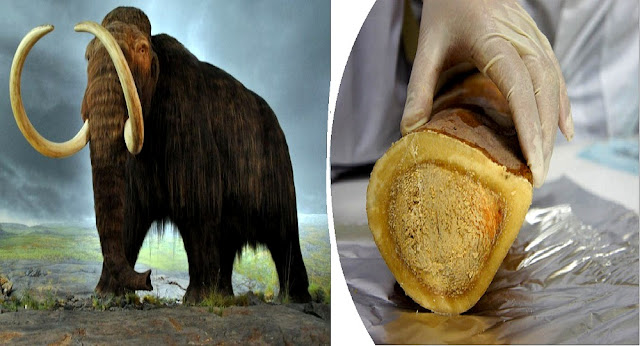Woolly Mammoth might be Back from Extinction Within Two Years, say Harvard scientists
 |
| The first image of mammoth bone marrow from which scientists are in search of to extract DNA. Picture: Semyon Grigoriev |
Scientist main ‘de-extinction’ effort says Harvard staff might create hybrid mammoth-elephant embryo in two years
The woolly mammoth vanished from the Earth A,000 years in the past, however now scientists say they’re getting ready to resurrecting the traditional beast in a revised type, by way of an formidable feat of genetic engineering.
Speaking forward of the American Association for the Advancement of Science (AAAS) annual assembly in Boston this week, the scientist main the “de-extinction” effort stated the Harvard staff is simply two years away from making a hybrid embryo, during which mammoth traits can be programmed into an Asian elephant.
“Our purpose is to supply a hybrid elephant-mammoth embryo,” stated Prof George Church. “Actually, it might be extra like an elephant with various mammoth traits. We’re not there but, however it might occur in a few years.”
The creature, typically known as a “mammophant”, can be partly elephant, however with options comparable to small ears, subcutaneous fats, lengthy shaggy hair and chilly-tailored blood. The mammoth genes for these traits are spliced into the elephant DNA utilizing the highly effective gene-modifying device, Crispr.
Until now, the group have stopped on the cell stage, however at the moment are shifting in the direction of creating embryos – though, they stated that it might be a few years earlier than any critical try at producing a dwelling creature.
“We’re engaged on methods to guage the impression of all these edits and principally making an attempt to determine embryogenesis within the lab,” stated Church.
Since beginning the undertaking in 2015 the researchers have elevated the variety of “edits” the place mammoth DNA has been spliced into the elephant genome from 15 to forty five.
“We already find out about ones to do with small ears, subcutaneous fats, hair and blood, however there are others that appear to be positively chosen,” he stated.
Church stated that these modifications might assist protect the Asian elephant, which is endangered, in an altered type. However, others have raised moral considerations concerning the venture.
Matthew Cobb, professor of zoology on the University of Manchester, stated: “The proposed ‘de-extinction’ of mammoths raises an enormous moral situation – the mammoth was not merely a set of genes, it was a social animal, as is the fashionable Asian elephant. What will occur when the elephant-mammoth hybrid is born? How will it’s greeted by elephants?”
Church additionally outlined plans to develop the hybrid animal inside a man-made womb quite than recruit a feminine elephant as a surrogate mom – a plan which some consider won’t be achievable inside the subsequent decade.
“We hope to do all the process ex-vivo (outdoors a dwelling physique),” he stated. “It can be unreasonable to place feminine copy in danger in an endangered species.”
He added that his lab is already able to rising a mouse embryo in a man-made womb for 10 days – midway by way of its gestation interval.
“We’re testing the expansion of mice ex-vivo. There are experiments within the literature from the Nineteen Eighties however there hasn’t been a lot curiosity for some time,” he stated. “Today we’ve received an entire new set of know-how and we’re taking a recent take a look at it.”
“Church’s staff is proposing to rear the embryo in an ‘synthetic womb’ which appears formidable to say the least – the resultant animal would have been disadvantaged of all of the pre-start interactions with its mom,” stated Cobb.
The woolly mammoth roamed throughout Europe, Asia, Africa and North America over the past Ice Age and vanished about A,000 years in the past, in all probability because of a mixture of local weather change and searching by people.
Their closest dwelling relative is the Asian, not the African, elephant.
“De-extincting” the mammoth has develop into a sensible prospect due to revolutionary gene modifying methods that permit the exact choice and insertion of DNA from specimens frozen over millennia in Siberian ice.
Church helped develop probably the most extensively used method, generally known as Crispr/Cas9, that has reworked genetic engineering because it was first demonstrated in 2012. Derived from a defence system micro organism use to fend off viruses, it permits the “reduce and paste” manipulation of strands of DNA with a precision not seen earlier than.
Gene modifying and its moral implications is among the key subjects beneath dialogue on the Boston convention.
Church, a visitor speaker on the assembly, stated the mammoth venture had two objectives: securing an alternate future for the endangered Asian elephant and serving to to fight international warming. Woolly mammoths might assist forestall tundra permafrost from melting and releasing big quantities of greenhouse fuel into the environment.
“They hold the tundra from thawing by punching by means of snow and permitting chilly air to return in,” stated Church. “In the summer time they knock down timber and assist the grass develop.”
The scientists intend to engineer elephant pores and skin cells to supply the embryo, or a number of embryos, utilizing cloning methods. Nuclei from the reprogrammed cells can be positioned into elephant egg cells whose personal genetic materials has been eliminated. The eggs would then be artificially stimulated to become embryos.
Church predicts that age-reversal will turn into a actuality inside 10 years because of the brand new developments in genetic engineering.
Church might be presenting his group’s newest analysis on the AAAS 2017 meeting.